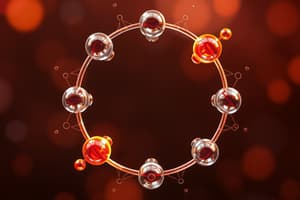Podcast
Questions and Answers
What does the enthalpy of solution represent?
What does the enthalpy of solution represent?
- The energy released when one mole of liquid is formed from gas.
- The enthalpy change when one mole of ionic solid is dissolved in water to infinite dilution. (correct)
- The enthalpy change when one mole of gas is liquefied.
- The enthalpy change when one mole of solid is formed from aqueous ions.
Why is the enthalpy of hydration typically negative?
Why is the enthalpy of hydration typically negative?
- Gaseous ions condense into liquids upon dissolution.
- The ions do not interact at all.
- All hydration processes require energy to occur.
- Water has a partially positive region that attracts negatively charged ions. (correct)
Which assumption is part of the perfect ionic model?
Which assumption is part of the perfect ionic model?
- Ions can easily be polarized.
- Ions are perfectly spherical. (correct)
- Ions have varying sizes and charge distributions.
- Ions exhibit significant covalent character.
How does the entropy of a substance change as temperature increases?
How does the entropy of a substance change as temperature increases?
What is the relationship between spontaneous reactions and entropy?
What is the relationship between spontaneous reactions and entropy?
Which option correctly describes the entropy change during vaporization compared to fusion?
Which option correctly describes the entropy change during vaporization compared to fusion?
What does Gibbs Free-Energy (∆G) allow researchers to do?
What does Gibbs Free-Energy (∆G) allow researchers to do?
In which state do substances exhibit the greatest entropy?
In which state do substances exhibit the greatest entropy?
What is the definition of lattice dissociation enthalpy?
What is the definition of lattice dissociation enthalpy?
Which term describes the energy needed to form a mole of gaseous atoms?
Which term describes the energy needed to form a mole of gaseous atoms?
How are enthalpy changes represented in a Born-Haber cycle?
How are enthalpy changes represented in a Born-Haber cycle?
What do lattice formation enthalpy and lattice dissociation enthalpy measure?
What do lattice formation enthalpy and lattice dissociation enthalpy measure?
What role do the enthalpy of solution and enthalpy of hydration play in thermodynamics?
What role do the enthalpy of solution and enthalpy of hydration play in thermodynamics?
In a Born-Haber cycle, what occurs if the cycle counters the direction of the enthalpy change arrow?
In a Born-Haber cycle, what occurs if the cycle counters the direction of the enthalpy change arrow?
Which of the following does not directly involve gaseous ions?
Which of the following does not directly involve gaseous ions?
What is the common feature of lattice enthalpies, atomisation enthalpy, and enthalpy of electron affinity?
What is the common feature of lattice enthalpies, atomisation enthalpy, and enthalpy of electron affinity?
Flashcards
Born-Haber Cycle
Born-Haber Cycle
A cycle that allows calculation of enthalpy changes that can't be measured directly.
Lattice Enthalpy (∆leH)
Lattice Enthalpy (∆leH)
Energy to break an ionic lattice into gaseous ions. Useful for ionic substances.
Lattice Dissociation Enthalpy
Lattice Dissociation Enthalpy
Energy to break an ionic lattice into gaseous ions.
Lattice Formation Enthalpy
Lattice Formation Enthalpy
Signup and view all the flashcards
Atomisation Enthalpy (∆atH)
Atomisation Enthalpy (∆atH)
Signup and view all the flashcards
Enthalpy of Electron Affinity (∆eaH)
Enthalpy of Electron Affinity (∆eaH)
Signup and view all the flashcards
Hess's Law
Hess's Law
Signup and view all the flashcards
Enthalpy of solution (∆solH) and hydration (∆hydH)
Enthalpy of solution (∆solH) and hydration (∆hydH)
Signup and view all the flashcards
Enthalpy of solution
Enthalpy of solution
Signup and view all the flashcards
Enthalpy of hydration
Enthalpy of hydration
Signup and view all the flashcards
Perfect ionic model
Perfect ionic model
Signup and view all the flashcards
Entropy (∆S)
Entropy (∆S)
Signup and view all the flashcards
Entropy change of vaporization
Entropy change of vaporization
Signup and view all the flashcards
Spontaneous reaction
Spontaneous reaction
Signup and view all the flashcards
Gibbs Free Energy (∆G)
Gibbs Free Energy (∆G)
Signup and view all the flashcards
Entropy and Temperature
Entropy and Temperature
Signup and view all the flashcards
Study Notes
AQA Chemistry A-level - Thermodynamics
3.1.8.1 Born-Haber Cycles
- Born-Haber cycles are similar to Hess's Law cycles, allowing calculation of enthalpy changes that can't be measured directly.
- Lattice Enthalpies (ΔH): Used for ionic substances, these represent the energy required to break an ionic lattice into gaseous ions.
- Lattice dissociation enthalpy: The energy needed to separate an ionic lattice into its gaseous ions.
- Lattice formation enthalpy: The energy required to form an ionic lattice from its gaseous ions.
- Atomisation Enthalpy (ΔatH): The energy needed to form one mole of gaseous atoms from the element in its standard state.
- Enthalpy of Electron Affinity (ΔH): The enthalpy change when one mole of electrons is added to a mole of gaseous atoms.
Born-Haber Cycle Example
- The example shows calculating enthalpy of formation (ΔHf°) of NaCl(s), calculating the enthalpy change by following the arrows until the desired state.
- If the cycle reverses the direction of the arrow, reverse the sign of the enthalpy change.
Enthalpies of Solution and Hydration
- Enthalpies of Solution (ΔsolH): The enthalpy change when one mole of an ionic solid dissolves in water to infinite dilution.
- Enthalpies of Hydration (ΔhydH): The enthalpy change when one mole of gaseous ions dissolves in water to form one mole of aqueous ions.
Perfect Ionic Model
- The perfect ionic model assumes ions are perfectly spherical and show no covalent character.
- Hydration enthalpy is affected by the size and charge of the ions. Covalent character occurs if the ions have varying sizes or charges leading to unequal distributions of charges.
3.1.8.2 Gibbs Free-Energy and Entropy
-
Entropy (ΔS): A measure of disorder; increasing temperature leads to more disorder.
-
Entropy increases from solids (ordered) to liquids (less ordered) to gases (disordered).
-
The entropy of vaporisation exceeds the entropy of fusion because gaseous state is more disordered than liquid.
-
Gibbs Free Energy (ΔG): ΔG = ΔH - TΔS (at constant temperature and pressure), this measures if a reaction or process will occur spontaneously.
-
Negative ΔG indicates spontaneous reactions.
-
A graph of ΔG against temperature will be a straight line with a negative gradient for spontaneous reactions.
-
If ΔH and ΔS are both positive or negative, a reaction feasibility depends on the temperature.
Studying That Suits You
Use AI to generate personalized quizzes and flashcards to suit your learning preferences.




